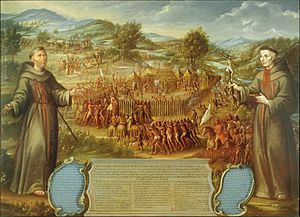José de Páez facts for kids
José de Páez (1720–1790) was a Mexican painter. He was known for his religious art. He also painted a famous historical scene: the destruction of the Mission Santa Cruz de San Sabá in Texas. Páez also created special paintings called "casta paintings." He was the son of Baltazar de Páez and a student of Nicolás Enríquez. He married Rosalía Caballero in 1753.
Biography
His paintings were very popular in New Spain (which is now Mexico). They were also known in Peru and Spain. He followed the artistic style of Miguel Cabrera. Páez was known for painting many religious pictures. He especially liked to paint scenes about the Virgin Mary. He was one of the most active artists in New Spain.
Art historians have looked closely at his work. Ilona Katzew described his style as "sentimental." This means his paintings showed a lot of feeling. His style was similar to Cabrera's, which might be why he was so successful. Some of his paintings have been found outside Mexico. This suggests he might have painted for people in other countries.
Páez created several sets of "casta paintings" around 1780. These paintings showed different groups of people. They illustrated how people of mixed backgrounds were seen in society. For example, one painting might show a Spanish person and an Indigenous person. Their child would be called a Mestizo. Another painting might show a Spanish person and a Mestiza. Their child would be called a Castizo. These paintings helped people understand the different social groups at the time.
Páez was a favorite painter of the Franciscans. These were members of a religious group. He painted a series of pictures about Saint Francis Solanus. These paintings are in the church of San Fernando in Mexico City. He was also asked to paint a dramatic scene. This painting showed the destruction of the Franciscan mission in Texas called San Sabá. It shows two Franciscan priests, Fray Alonso Giraldo de Terreros and Fray José de Santiesteban, being killed. It also shows the Comanche warriors who attacked the mission. This painting is one of the earliest known artworks showing a scene from northern Texas. A relative of Fray Alonso, Don Pedro Romero de Terreros, asked Páez to paint it. The painting was finished around 1765.
Gallery
See also
 In Spanish: José de Páez para niños
In Spanish: José de Páez para niños
- Casta painting
- Mexican art




